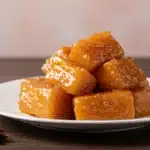Table of Contents
ToggleWelcome to Recipes2Gather Blog—where comforting classics meet quick kitchen wins. If you’re looking for a side dish that feels like a warm hug from the holidays, you’re going to fall in love with candied yams. Sweet, buttery, and kissed with cinnamon, this nostalgic recipe is a must-have at family dinners and festive gatherings. Whether you’re serving them at Thanksgiving or just craving a cozy, down-home flavor, these candied yams hit the sweet spot every time. In this guide, you’ll learn how to whip up the best version of this beloved Southern classic using simple ingredients and foolproof techniques.
Craving more festive dishes? Be sure to check out our Christmas Cranberry Salad for another holiday favorite.
Key Benefits
Candied yams aren’t just a treat for the taste buds—they bring a host of comforting benefits to the table.
First, this dish is incredibly easy to prepare, even for beginners. With a short ingredient list and clear steps, you can make it without breaking a sweat, whether you’re preparing a holiday meal or a weeknight dinner.
Second, yams are naturally packed with nutrients like fiber, potassium, and beta carotene, making this indulgent side surprisingly wholesome. When prepared with real butter and a touch of maple syrup, you get a sweet dish that still offers essential vitamins and minerals.
Third, candied yams are the ultimate comfort food. Their soft texture, rich syrup, and warm spices evoke childhood memories and holiday nostalgia. They’re often the first dish to disappear from the dinner table.
Lastly, this recipe is highly versatile. You can adjust the sweetness, add spices like nutmeg or cloves, or even top it with marshmallows or pecans. You can also make a healthier twist with less sugar, which we’ll explore in the pro tips section.
And if you’re already planning your full comfort menu, pair these yams with our classic Old-Fashioned Baked Macaroni and Cheese for a truly satisfying plate.
Ingredients for Candied Yams
To make candied yams, you only need a handful of pantry staples and fresh yams. Here’s everything you’ll need:

- Fresh yams or sweet potatoes – About 2 pounds, peeled and sliced into ½-inch thick rounds
- Unsalted butter – ½ cup, for that rich, melt-in-your-mouth flavor
- Brown sugar – ¾ cup, packed; dark brown sugar gives deeper molasses notes
- Granulated sugar – ¼ cup, optional for extra sweetness
- Ground cinnamon – 1 teaspoon
- Ground nutmeg – ½ teaspoon
- Vanilla extract – 1 teaspoon
- Salt – A tiny dash helps cut through the sweetness and brings all the flavors together.
- Water or orange juice – ¼ cup to keep everything moist and give the dish a nice flavor boost.
Optional additions:
- Mini marshmallows (for topping before baking)
- Chopped pecans (for crunch and nuttiness)
- A dash of ground cloves or ginger for added spice
Using ingredients like these keeps your dish cozy, familiar, and full of flavor. Curious how to make more meals with what you’ve already got in the pantry? Browse our tips on making Cottage Cheese Sauce for Chicken.
Step-by-Step Instructions for Candied Yams
Here’s how to make the perfect batch of candied yams from scratch:

- Preheat your oven to 350°F (175°C).
- Get your yams ready by peeling them and cutting them into slices about half an inch thick. This ensures they cook evenly and absorb all that sugary goodness.
- Layer the yams: In a greased baking dish, arrange the yam slices in an overlapping pattern.
- To make the syrup, warm the butter in a pan over medium heat until it’s fully melted. Stir in both sugars, cinnamon, nutmeg, vanilla, salt, and water (or orange juice). Let it simmer until everything is dissolved and the mixture becomes syrupy—about 5 minutes.
- Pour and cover: Carefully pour the hot syrup over the yams, making sure every slice gets coated. Seal the baking dish snugly with foil to lock in the heat and moisture.
- Bake covered for 30 minutes. This helps the yams begin to soften and absorb the syrup.
- Uncover and bake for another 30 minutes. Baste the yams with the syrup halfway through this step. The syrup will bubble up and get nice and thick, with a rich, caramel-like finish.
- Optional: If using marshmallows, add them in the last 10 minutes and broil until golden brown.
That’s it! Now your kitchen smells like the holidays, and your dish is ready to impress. This method is perfect for recreating the comfort of dishes like our Pumpkin Dump Cake—another seasonal favorite.
Pro Tips and Variations for Candied Yams
Making candied yams your own is part of the fun. Want to take your yams to the next level? Try these helpful tricks:
- Use orange juice instead of water for a citrusy twist that balances sweetness with brightness.
- Toss on some marshmallows or chopped pecans near the end of baking for a little crunch or gooey goodness on top.
- Planning ahead? You can easily make this a day early and just reheat when you’re ready to serve. Just bake it, cool, and refrigerate. Just pop it back in the oven at 350°F, covered with foil, and warm it up until it’s hot and bubbly.
- Health-conscious tweaks: Use coconut sugar or maple syrup as a natural sweetener. Swap in vegan butter for a dairy-free version.
- Boost the spice: For a deeper flavor profile, mix in a dash of ground ginger, cloves, or even a sprinkle of cardamom.
You can also take inspiration from fusion desserts like our Churro Cheesecake if you’re feeling creative.
Serving Suggestions for Candied Yams
Candied yams are a standout side dish, but they can shine even brighter with the right pairings:
- Classic holiday dinners: Serve them alongside roast turkey, ham, or Green Bean Casserole.
- Sunday soul food: Pair with fried chicken, collard greens, and cornbread for a comforting Southern-style feast.
- Brunch table addition: They’re surprisingly perfect with eggs, biscuits, and bacon for a sweet-savory breakfast.
- Creative leftovers: Mash and spread on toast, add to sweet potato pancakes, or swirl into muffin batter.
For a sweet ending to the meal, try serving yams as dessert—drizzled with whipped cream or a scoop of vanilla ice cream.
Looking for more ways to sweeten up the table? Try our German Chocolate Cookies for dessert.
Trusted Resources for Candied Yams
- Sweet potatoes are rich in antioxidants and fiber which can help support gut health and overall wellness.
- Butter is essential for flavor and texture in baked dishes like candied yams.
- Brown sugar gives a deeper caramel flavor due to its molasses content.
- Cinnamon offers more than spice—it contains anti-inflammatory properties.
Conclusion
Candied yams bring warmth, sweetness, and tradition to any table. Whether you’re honoring a family recipe or creating your own twist, this dish is all about celebrating flavors and memories. With simple steps and customizable ingredients, anyone can create a side that’s both nostalgic and incredibly satisfying. So the next time you’re gathering friends or planning a holiday spread, don’t forget these caramel-glazed gems.
Explore more nostalgic recipes like our Shirley Temple Punch for a sweet and bubbly pairing.
Print
Candied Yams Delightfully Easy Sweet Holiday Treat
5 Stars 4 Stars 3 Stars 2 Stars 1 Star
No reviews
- Author: Chef Jennifer
- Total Time: 1 hour 15 minutes
- Yield: 6 servings
- Diet: Vegetarian
Description
These sweet and buttery candied yams are baked to perfection in a spiced syrup and make the perfect side for holidays or soul food dinners.
Ingredients
- 2 lbs yams or sweet potatoes, peeled and sliced
- ½ cup unsalted butter
- ¾ cup brown sugar
- ¼ cup granulated sugar (optional)
- 1 tsp cinnamon
- ½ tsp nutmeg
- 1 tsp vanilla extract
- Pinch of salt
- ¼ cup water or orange juice
- Optional: marshmallows or chopped pecans
Instructions
- Preheat oven to 350°F.
- Layer yam slices in a greased baking dish.
- In a saucepan, melt butter. Stir in sugars, spices, vanilla, and liquid. Simmer 5 minutes.
- Pour syrup over yams. Cover with foil.
- Bake for 30 minutes.
- Remove foil, baste, and bake another 30 minutes.
- Add marshmallows or pecans if desired; broil briefly.
- Serve warm.
Notes
Great for holidays. Easily made ahead. Customize with toppings or spice variations.
- Prep Time: 15 minutes
- Cook Time: 1 hour
- Category: Main Dish
- Method: Baked
- Cuisine: Southern American
FAQs
Can I use canned yams instead of fresh?
Yes, but drain them well and reduce baking time to 20–25 minutes since they’re already cooked.
Are candied yams the same as sweet potatoes?
In most American kitchens, the terms “yams” and “sweet potatoes” get used pretty much the same—even though they’re technically different. This recipe works perfectly with either.
What’s the best way to prep this dish before the big day?
Prepare fully, cool, and refrigerate. Reheat at 350°F covered in foil until hot.
What’s the best topping—marshmallows or pecans?
Both are delicious! Marshmallows give a gooey sweetness, while pecans offer a toasty crunch. Mix and match if you like.

